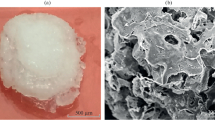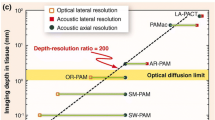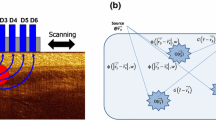Abstract
Creation of new effective bio-artificial structures for tissue engineering and regenerative medicine requires development and implementation of new technological approaches for analysis of micro- and nanostructural features of constructs based on biomaterials and their interaction with cells. A new method of three-dimensional multiparametric analysis of nanostructure, scanning optical probe nanotomography, is presented in this paper, applied to the analysis of cells and biomaterials. Correlative reconstruction of fluorescent marker distributions and nanostructure features allows quantitative evaluation of a number of parameters of three-dimensional nanomorphology of fibroblasts and human hepatocarcinoma cells Hep-G2, adhered to biodegradable scaffolds based on silk fibroin. The developed technology with use of scanning optical probe nanotomography is applicable to investigation of three-dimensional micro- and nanostructure features of biomaterials and cells of different types.

Similar content being viewed by others
REFERENCES
Caplan, J., Niethammer, M., and Taylor, R.M., et al., The power of correlative microscopy: multi-modal, multi-scale, multi-dimensional, Curr. Opin. Struct. Biol., 2011, vol. 21, no. 5, pp. 686–693.
Mochalov, K.E., Chistyakov, A.A., Solovyeva, D.O., et al., An instrumental approach to combining confocal microspectroscopy and 3D scanning probe nanotomography, Ultramicroscopy, 2017, vol. 182, pp. 118–123.
Efimov, A.E., Moisenovich, M.M., Bogush, V.G., et al., 3D nanostructural analysis of silk fibroin and recombinant spidroin 1 scaffolds by scanning probe nanotomography, RSC Adv., 2014, vol. 4, pp. 60943–60947.
Vepari, C. and Kaplan, D.L., Silk as a biomaterial, Progr. Polymer Sci., 2007, vol. 32, pp. 991–1007.
Koh, L.-D., Cheng, Y., Teng, C.-P., et al., Structures, mechanical properties and applications of silk fibroin materials, Progr. Polymer Sci., 2015, vol. 46, pp. 86–110.
Agapov, I.I., Agapova, O.I., Bobrova, M.M., et al., Substrate for the study of a biological sample by scanning probe nanotomography and a method for its preparation, RF Patent no. 2740872, Byull. Izobret., 2021, no. 3.
Efimov, A.E., Agapova, O.I., Safonova, L.A., et al., Cryo scanning probe nanotomography study of the structure of alginate microcarriers, RSC Adv., 2017, vol. 7, no. 15, pp. 8808–8815.
Keren, K., Pincus, Z., Allen, G.M., et al., Mechanism of shape determination in motile cells, Nature, 2008, vol. 453, pp. 475–481.
Krobath, H., Schutz, G.J., Lipowsky, R., et al., Lateral diffusion of receptor-ligand bonds in membrane adhesion zones: effect of thermal membrane roughness, Europhys. Lett., 2007, vol. 78, pp. 38003/1–38003/6.
Reister, E., Bihr, T., Seifert, U., et al., Two intertwined facets of adherent membranes: membrane roughness and correlations between ligand-receptors bonds, New J. Phys., 2011, vol. 13, pp. 025003/1–025003/15.
Antonio, P.D., Lasalvia, M., Perna, G., et al., Scale independent roughness value of cell membranes studied by means of AFM technique, Biochim. Biophys. Acta—Biomembranes, 2012, vol. 1818, pp. 3141–3148.
Lee, H., Veerapandian, M., Kim, B.T., et al., Functional nanoparticles translocation into cell and adhesion force curve analysis, J. Nanosci. Nanotechnol., 2012, vol. 12, pp. 7752–7763.
Wang, Y., Xu, C., Jiang, N., et al., Quantitative analysis of the cell-surface roughness and viscoelasticity for breast cancer cells discrimination using atomic force microscopy, Scanning, 2016, vol. 38, pp. 558–563.
Staykova, M., Holmes, D.P., Read, C., et al., Mechanics of surface area regulation in cells examined with confined lipid membranes, Proc. Natl. Acad. Sci. U. S. A., 2011, vol. 108, pp. 9084–9088.
Funding
This work was partially supported by the program of the President of the Russian Federation for state support of leading scientific schools of the Russian Federation (project no. NSh-2598.2020.7).
Author information
Authors and Affiliations
Corresponding author
Ethics declarations
The authors declare that they have no conflict of interests. This article does not contain any studies involving animals or human participants performed by any of the authors.
Rights and permissions
About this article
Cite this article
Agapova, O.I., Efimov, A.E., Safonova, L.A. et al. Scanning Optical Probe Nanotomography for Investigation of the Structure of Biomaterials and Cells. Dokl Biochem Biophys 500, 331–334 (2021). https://doi.org/10.1134/S160767292105001X
Received:
Revised:
Accepted:
Published:
Issue Date:
DOI: https://doi.org/10.1134/S160767292105001X




